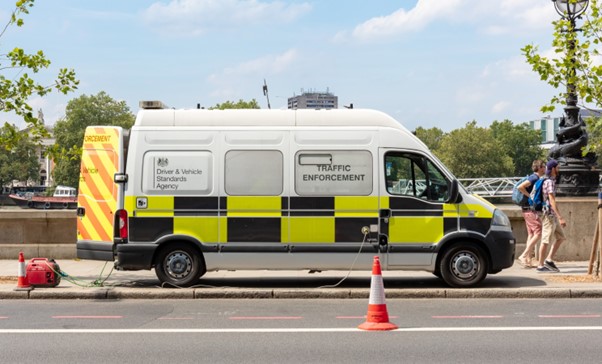
Susie Jones
I controlli DVSA per gli automezzi pesanti spiegati
Creato: 08/08/2024
•
Aggiornato: 08/08/2024
Durante la vostra carriera di camionisti, potreste essere fermati dalla Driver and Vehicle Standards Agency (DVSA). Per gli autisti di camion che si affacciano al settore, questo può essere un processo scoraggiante. Tuttavia, la comprensione degli aspetti essenziali dei controlli DVSA sui camion può rendere il processo meno stressante.
Chi è la DVSA?
Secondo Gov.uk, la DVSA è responsabile di "effettuare controlli su strada su conducenti e veicoli commerciali per assicurarsi che rispettino le norme di sicurezza e che il loro veicolo sia sicuro da guidare".
La DVSA può effettuare controlli a campione sul vostro camion ed emettere divieti. I divieti impediscono all'autista di camion di guidare fino a quando non viene risolto il problema del suo veicolo.
La polizia ha anche l'autorità di fermare un camionista ed effettuare controlli simili.
Che aspetto hanno gli esaminatori DVSA?
Ci sono alcuni modi per identificare un esaminatore DVSA. Indossano giubbotti di visibilità gialli con il logo DVSA e hanno sempre una carta di mandato. I loro veicoli hanno una stampa nera e gialla con il logo DVSA sul cofano.

Cosa succede se si viene fermati?
Non fermarsi quando viene richiesto da un esaminatore DVSA è un'infrazione. Se un esaminatore vi chiede di accostare, effettuerà il controllo a bordo strada o in un sito di prova dedicato. Lo scopo principale di questi fermi è quello di tenere lontani dalla strada i veicoli non sicuri.
Un esaminatore eseguirà i seguenti controlli obbligatori:
Verifica del peso del carico autorizzato e del tipo di carico
Controllo dei guasti meccanici e delle condizioni stradali
Assicurarsi che i registri del tachigrafo siano corretti
Assicuratevi di avere una patente di guida valida.
Quanto dura un controllo DVSA walkaround?
In media, un controllo DVSA dura 15 minuti. Tuttavia, nei casi in cui il camion non soddisfa i requisiti di sicurezza, può richiedere più tempo. L'esaminatore deve eseguire i controlli necessari, indipendentemente dal tempo.
Come assicurarsi che il proprio veicolo sia in regola con le norme stradali
È responsabilità dell'autista assicurarsi che il proprio veicolo sia idoneo alla circolazione. Si raccomanda di effettuare un controllo a piedi prima di ogni viaggio.
Controllare i seguenti elementi:
Luci
Indicatori
Carburante e olio
Pneumatici
Fissaggi delle ruote
Carrozzeria
Aggancio del rimorchio
Carico e altre attrezzature
Controllo del veicolo in cabina (ad es. cinture di sicurezza, clacson, tergicristalli, lavavetri, sterzo e indicatore di altezza).
Inoltre, è responsabilità dell'autista del camion segnalare per iscritto alla propria organizzazione eventuali difetti. Tali segnalazioni devono includere quanto segue:
Targa o marchio di identificazione del veicolo
Data dell'ispezione
Dettagli dei difetti
Nome della persona che segnala i difetti.
Responsabilità dell'operatore
Gli operatori dei veicoli hanno la responsabilità di garantire la sicurezza dei loro veicoli e devono effettuare le seguenti operazioni:
L'operatore deve garantire l'esecuzione di regolari ispezioni di sicurezza per tutti i veicoli commerciali.
Devono assicurarsi che i loro conducenti comprendano quali controlli devono essere effettuati.
Divieti di circolazione
Se il vostro autocarro non è idoneo alla circolazione, la DVSA può emettere due diversi avvisi di divieto: immediato o differito.
Avviso di divieto immediato:
Può entrare in vigore immediatamente
Nella maggior parte dei casi, il veicolo viene immobilizzato.
I divieti immediati possono portare a un'azione penale.
Avviso di divieto ritardato:
L'operatore ha a disposizione fino a 10 giorni per risolvere i problemi.
Dopo dieci giorni, gli agenti ispezioneranno nuovamente il veicolo.
I divieti devono essere rimossi prima che il carrello possa essere guidato.
Divieti di circolazione
Se l'autocarro presenta problemi meccanici o se la carrozzeria e l'equipaggiamento sono di scarsa qualità, viene emesso un divieto di circolazione. Per i veicoli al di fuori del Regno Unito, il conducente riceverà un divieto immediato. Per gli operatori del Regno Unito, il tipo di divieto dipenderà dalla gravità del difetto.
Difetti minori:
I difetti minori possono comportare un'interdizione ritardata.
L'operatore avrà a disposizione fino a dieci giorni per risolvere eventuali difetti.
Dopo dieci giorni si procederà a una nuova ispezione.
Difetti gravi:
Il conducente riceverà un divieto contrassegnato con la lettera "S" per un difetto grave.
Un divieto contrassegnato con una "S" si verifica quando c'è un problema di manutenzione.
Se l'esaminatore decide che non c'è un rischio immediato, i divieti possono essere ritardati.
Il veicolo verrà immobilizzato e potreste essere perseguiti penalmente.
Un divieto contrassegnato con "S" non si verificherà per quanto segue:
Se si verifica un problema durante il viaggio
Non è stato possibile rilevare il problema (ad esempio, un difetto della parte inferiore).

Divieti di sovraccarico
Se il veicolo è sovraccarico, un esaminatore DVSA può immobilizzarlo. In alternativa, l'esaminatore può indirizzare il camion verso un luogo vicino dove il carico può essere ridistribuito o rimosso. L'operatore del veicolo riceverà un avviso.
Divieti relativi alle ore di guida
I conducenti che non hanno rispettato le regole relative al tachigrafo e alle ore di guida riceveranno un divieto. Questo può comportare una multa, un'azione penale o il fermo del veicolo.
Per saperne di più su norme e regolamenti sul tachigrafo
Sebbene l'esame DVSA possa essere una prospettiva scoraggiante per gli autisti di camion, è innegabile che sia una forza positiva per la sicurezza stradale. Assicurandosi di effettuare i controlli corretti e di seguire le norme e i regolamenti essenziali, l'esame DVSA si svolgerà senza problemi.
Per quanto tempo dovete conservare le schede dei difetti degli autocarri?
L'implementazione di un sistema di segnalazione dei difetti può essere la prima linea di difesa per dimostrare che i vostri veicoli sono in condizioni di sicurezza stradale. Gli interventi di correzione dei difetti devono essere segnalati e conservati per un massimo di 15 mesi. In assenza di difetti, l'azienda deve conservare i registri per garantire che i conducenti effettuino i loro controlli.
Con quale frequenza ha bisogno di un medico per mantenere la sua patente?
Per ottenere e detenere una patente HGV, è obbligatorio sottoporsi a un esame medico HGV, senza il quale la patente non viene rilasciata.
Per i conducenti di età inferiore ai 45 anni, l'esame medico durerà fino al compimento del 45° anno di età. Tuttavia, dopo questa età, sarà necessario superare l'esame medico ogni cinque anni fino a 65 anni. I conducenti di 65 anni e oltre sono tenuti a superare l'esame medico ogni anno.



